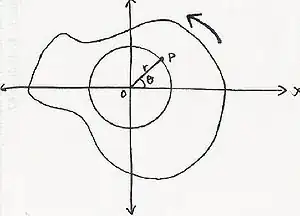On wikipedea I found a definition of an Angle as such:
"In order to measure an angle θ, a circular arc centered at the vertex of the angle is drawn, e.g. with a pair of compasses. The length of the arc s is then divided by the radius of the arc r, and possibly multiplied by a scaling constant $k$ (which depends on the units of measurement that are chosen): $$\theta = k \frac{s}{r}.$$ The value of θ thus defined is independent of the size of the circle: if the length of the radius is changed then the arc length changes in the same proportion, so the ratio $s/r$ is unaltered.'
And the definition of circular arc is given as:
"a circular arc is a segment of a circle, or of its circumference (boundary) if the circle is considered to be a disc."
Now since circular arc is a segment of a circle we are not supposed to have circular arc of length more than circumference of the circle. So we cannot define angles more than $2\pi$ in this manner. But I found a topic in the book, "Unified algebra and trigonometry" (Addison-Wesley mathematics series) art 3-5. I've posted it as an answer to the question
https://physics.stackexchange.com/questions/87057/angular-displacement/87066#87066.
There the author of the book explains that we can have circular arc more than the circumference of a circle as:
"....where the circular arc $\stackrel \frown {PP}^{′}$ denoted by $s$,.... since the number of revolutions of any angle is determined by the ratio of the intercepted circular arc length $s$ to circumference of the circle we define, magnitude of an angle in revolutions as
Angle in revolutions$ = s/2πr$..."
means there can be angles of more than $2\pi$ .
Question1:Does the definition of an angle depends upon its use in physics?
Question2: if we assign a point on a solid body named $P$ having an initial angle $\theta$ after this solid body rotates a full circle can we assume the angle of point $P$ after the revolution to be again $\theta$ or $\theta +2\pi$. Please state a precise definition to support the validity of this argument.
 As I understands if we assign polar-coordinates to point $P$ these polar coordinates will be $(\pm r,\theta\pm 2n\pi)$ and but if rotation is involved should we consider the angle used as "oriented" or "non-oriented".
As I understands if we assign polar-coordinates to point $P$ these polar coordinates will be $(\pm r,\theta\pm 2n\pi)$ and but if rotation is involved should we consider the angle used as "oriented" or "non-oriented".